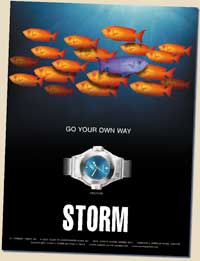|
||||||||||
|
|||||||||||
|
|||||||||||
|
%
responses 2006 ('02) |
||||||||||
| y4 |
y8
|
||||||||||
1. What do you think they mean when they say “Go your own way”? |
|||||||||||
don’t follow the crowd/make your own decisions |
45 (50) |
66 (69) |
|||||||||
buy this watch |
3 (6) |
16 (23) |
|||||||||
2. How do you think they use the pictures to show the message, “Go your own way”? prompt: Is there anything else? |
|||||||||||
blue fish swimming in opposite
direction to orange fish |
89 (83) |
94 (90) |
|||||||||
3. What has this message, “Go your own way”, got to do with watches? |
|||||||||||
this is a special/different sort of watch |
6 (12) |
31 (35) |
|||||||||
be adventurous and buy this watch |
4 (7) |
14 (24) |
|||||||||
Total
score: |
4–5 |
1 (2) |
11 (19) |
||||||||
3 |
5 (10) |
22 (28) |
|||||||||
2 |
41 (41) |
45 (28) |
|||||||||
1 |
44 (36) |
19 (20) |
|||||||||
0 |
7 (11) |
3 (5) |
|||||||||
| Subgroup Analysis: |
Year 4 |
||
Year 8 |
| Commentary: |
| This task, which required students to think critically about advertising, was challenging for year 4 students. Performances in 2006 were similar to those of 2002. There were no gender differences. In year 4, the Pakeha students performed slightly better than the Mäori or Pasifika students. In year 8, the Pakeha and Mäori students performed somewhat better than Pasifika students. |
